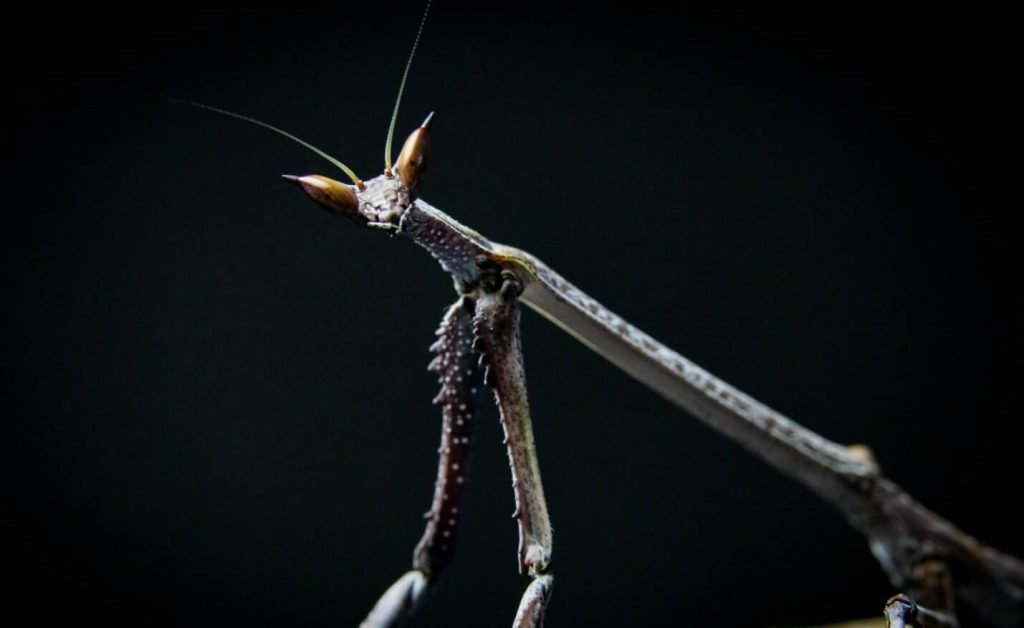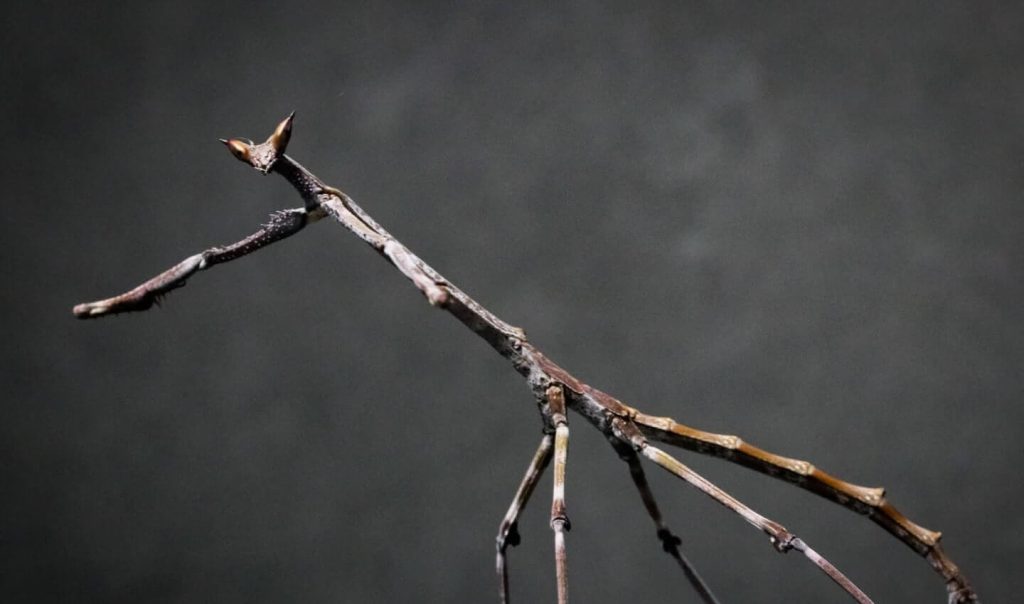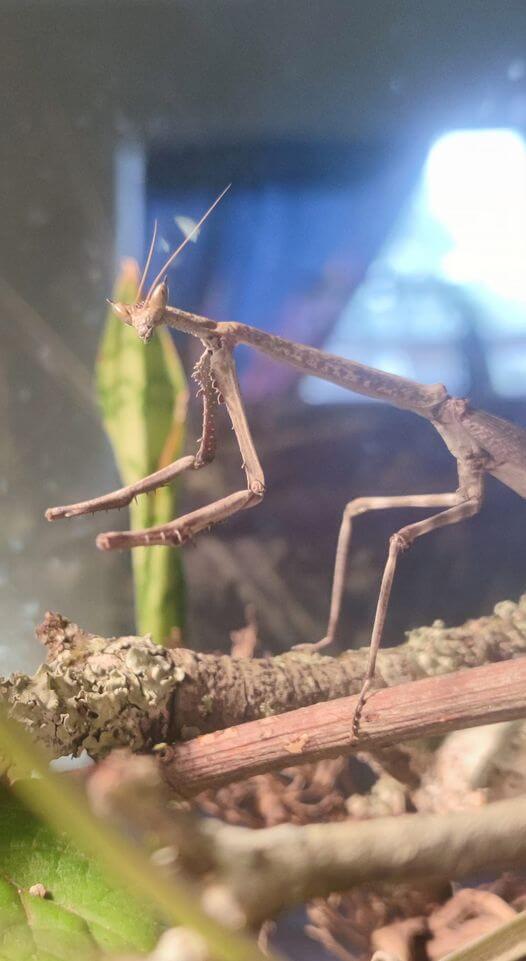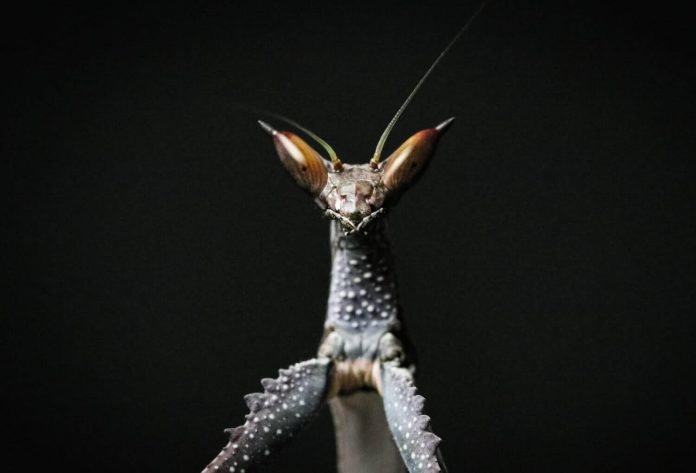Are you looking for a good pet or trying to learn about a new species? Then cat eye mantises would be something worth looking into. Talking about mantises in general, These fascinating insects can be called by many names, but they are powerful predators. Their triangular heads are held on a long neck or elongated chest. Mantids have two large compound eyes and three simple eyes between them. They can rotate their heads 180 degrees to view the surrounding environment.
Mantis species are usually green or brown and can be camouflaged well on the plants where they live. Their front legs are used to catch their prey, and they have reflexes so fast that it is difficult for the naked eye to see their movements. They also have spikes on their legs for snatching prey and keeping it in place.

Introduction
This variety of the mantis family is usually called by three names: cat eye mantis/giant African stick mantis/ ‘Chaeta. And scientifically known as Hetorochaeta Orientalis. And this species is relatively new in culture. They are L1 Nymphs and measure just over an inch in length.
Appearance
Cat eye mantis is one of the largest species in the praying mantis family, with some measuring over half a foot in length. The stick-looking cat eye mantis has a long, slender appearance that looks almost like a piece of a branch. The cat eye mantis has got two conical protrusions at the top of each eye that is distinctive even in the hatchling stage. Cat eye mantis is usually medium-to-dark brown in color and can sometimes show tinges or green during its nymph stage. Red horns can also be seen with blue or green eyes.
Origin
Cat eye mantis is an African mantis that originated from central Africa. It was first discovered in Tanzania.
Development
Growth rate and other factors
Cat eye mantis is a slow-growing species of mantis. The first molt lasts approximately two weeks. The last molt may take up to two months. With warmer temperatures and regular feeding, a cat eye mantis can grow faster than other mantids.
How Big Do Cat Eye Mantis Get?
The giant African mantis, also known as the Cat Eye mantis, doesn’t surprise why it has that name. They can grow up to 15cm in size for females and 12cm in males. This species is very similar to a cat and is becoming more popular in the pet world.
How Long Do Cat Eye Mantis Live?
The average life span of a cat eye mantis from hatchling to adulthood can be at least one year, and in ideal conditions, it can last for almost two years.
When Do Cat Eye Mantis Moult?
The cat eye mantis will often look for a spot that is camouflaged. From this spot, it will lay upside down and shed its skin. Most cat eye mantis species molt in unison within the same two-day window. Before molting, a cat eye mantis may refuse to eat.

Behaviour
- Chaeta is a passive mantis and tends to spend most of its time in one place, even as a nymph.
- Cat eye mantis is very shy and docile. They don’t hunt prey, but they are ambush predators that rely on their camouflage to lure prey closer.
- If given ample space and good food, cat eye mantis can have a very low rate of cannibalization. The Cat eye mantis is one of the most culturally tolerant mantises.
- Cat eye mantis is prone to threat display and eye-to-eye interaction. It will usually take a threat pose if it sees a movement that is quick and previously unnoticed. And will extend its coxa horizontally and expose its warning colors. As an adult, cat eye mantis will only open its wing set when it is in extremely confrontational situations.
Environment
Temperature Level
Cat eye mantis is tolerant to high heat and humidity, so living conditions may vary. It thrives best in rooms that are between 60 and 80 degrees F with at least 30% humidity.
Tank / Cage Requirements
Cat eye mantis must be placed in a container that is 3x its diameter and 6x its height. It needs a lot of living space and molting. This is the most difficult part of keeping a mantis.
The Substrate
Cat eye mantis does not require a substrate. However, it is important to maintain at least 30% humidity. A good spray every other day is a good idea. However, They will not die or mismolt if they aren’t given enough moisture.
Tank Furnishing
Cat eye mantis needs a crypsis environment. Birch branches are the best choice. A low-wattage CFL is a great idea for them to attract food sources. They need a wider environment. Their predatory instincts of them are activated when prey flies to the light source. During feedings, sometimes they crowd around the light.
Communal Housing If Applicable
The Cat eye mantis is one of the most communicative mantises I have ever kept and is a cultural icon. Cannibalization is always possible if there isn’t enough food, adequate camouflage, and too much interaction.

Feeding
- Cat eye mantis isn’t an active hunter like other mantids. Instead, it waits until the food is within striking range before launching out. It will gradually make its way toward a group of prey items.
- Cat eye mantis can defeat larger enemies than you might expect despite its slim stick-like build. Them at the 1st Instar can eat mels or hydei. Their second and fourth instars can jump to houseflies. At the fourth Instar, blue bottles can be used throughout adulthood.
- Cat eye mantises are slimmer than other prey and can overcome large prey. This means that their frequency of feeding is determined by their size. L1 through 3 should be fed two times a week. Hydeis x6-12 for each chaeta and house fly. After they reach blue bottles, they should be fed twice a week. They will need a bigger tank that can hold 1bb per instar. If the food has been eaten, it should be continued to be fed. Mated females will eat almost twice as much food. Although adult chaeta can survive for several weeks without food, that is not recommended.
Breeding
Sexing
The naked eye can’t see any difference in cat eye mantis between males and females until L5. Females are slightly bigger and bulkier than males. Males have larger, more extensive antennae. The arch of the female’s cerci curves downwards just before its two flaps at their abdomen. Males are also flight-capable and have slightly longer wings set.
From The Last Molt Until Copulation
Between adulthood and first witnessed marriage, it takes between 4-6 weeks. This time period is dependent on many environmental factors.
Tips
- The best way to get cat eye mantises to mate is to keep them together from the beginning and to give them more food and privacy when they need it.
- Higher temperatures and humidity don’t play as big a role in mating as the natural environment.
- Females usually lay every other week after mating. However, it can take up to a whole month. For larger, healthier teeth, it may be necessary to provide food and misting more often.
- Diapause if necessary: cat eye mantis ooths do not require a diapause.
Incubation Time
Cat eye mantis oothecae takes approximately 45-60 days from the date of laying to the date of hatching. Living temperatures and hatching shouldn’t be different.
Range Of Hatching
Healthy mantis ooths should be in the 50-60 range. Even the smallest of their ooths can produce 10 mantids.
**OOTHS are not always guaranteed to hatch. It can take up to 10 weeks for them to hatch. They are both fertile and captive-bred, but we can assure you that they are fertile.**
